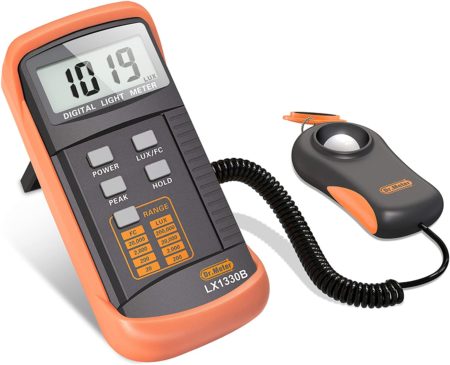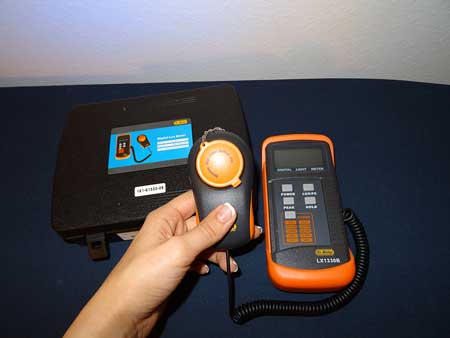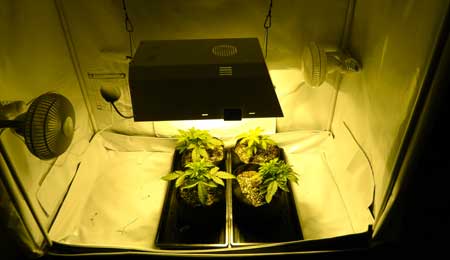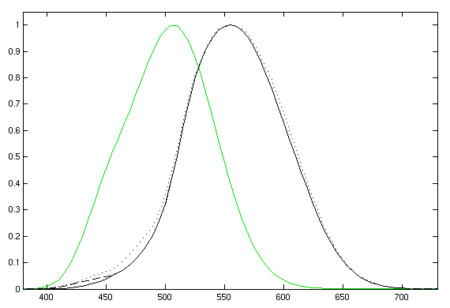by Nebula Haze
Did you know you can get more out of your grow lights by measuring your light levels with a lux meter?
Have you ever wondered if there was some way to measure how much light your plants are receiving in your indoor cannabis grow?
Well, there’s a solution – a lux meter! Lux meters measure brightness. “Lux” is the measure of how many lumens per square meter are being received at a point in space. Lumens is a measure of light. So, in other words, a lux meter can tell you the amount of light received at any specific point in your grow area.
How does a lux meter help you?
Bigger Yields – Plants which get the right amount of light grow faster and produce bigger yields. A lux meter helps you find the “sweet spot” for your grow light where your plants get the highest amount of light without getting burned. It also helps you space out your plants and try different configurations with your light to maximize the amount of plant matter in the sweet spot.
Test Your Bulbs – You can use a lux meter to find out when you need to get new bulbs. Most grow lights with replaceable bulbs get weaker over time and need to be replaced every few grows (some more than others, for example LEDs can last for years). A lux meter can help you know exactly when it’s time to replace your bulbs.
Healthier Growth – You can find out when certain parts of the plant are getting too much or not enough light. Lux meters can also help you avoid light burn caused by too-high levels of lux.
Better Than Your Eyes – It can be difficult to just look at a space and know exactly which parts are getting the most light. We try our best, but a lux meter can show you small adjustments that make a big difference. Sometimes moving a plant or adjusting a grow light by a few inches can make a surprisingly big difference.
The grow shown below was the first time I ever used a lux meter. For this grow I was using a 250W HPS light for the first time. I wasn’t familiar with how far to keep the light away from my plants. Luckily, I had a lux meter to give me definitive answers. I started testing light levels and how they vary with the position of the light distance and the plants.
I found out that 11-12″ was the best distance to keep my 250W light from these plants
And I kept testing lux levels throughout their life!
As the plants grew, I kept checking to make sure they were all getting the same amount of light. After my plants hit the flowering stage and started making buds, I found out that I could get more light to ALL parts of all the plants by moving everything 3 inches to the right. How crazy is that? There’s no way I would have figured that out on my own just by looking at the plants. It all had to do with the shape of the plants and how the colas were making shadows compared to their position underneath the light.
Here’s a quick video showing you what I mean:
So a lux meter gave me the tools to get bigger yields by getting more light to my plants. The best part is I didn’t have to change my grow light – I was able to get better performance out of the same lights with different positioning.
Using a Lux Meter for Different Types of Grow Lights
As you would probably guess, a lux meter measures “lux” (a measurement of “luminous flux” in an area). Roughly speaking, lux measures the amount of light visible to the human eye. However, some grow lights produce light in a part of the spectrum (infrared and ultraviolet) that can’t be seen by human eyes. A lux meter doesn’t count that non-visible light and would give a reading that is lower than the actual amount of light being produced that the plant can use.
A lux meter also doesn’t measure PAR (Photosynthetically Active Radiation), which is a term you’ll see a lot when talking about grow lights. This is because PAR measures light that can be used for plant photosynthesis, while lux measures visible light for humans.
So it sounds like lux meters aren’t helpful for grow lights, right? Nope!
The range of light used by plants and the light spectrum visible to humans is surprisingly similar. You can buy expensive equipment to accurately measure light levels in the PAR range, but a lux meter is often enough for a hobbyist grower to get a good idea of how much light plants are getting. Just remember your measurements are an estimate and leave a little wiggle room for error.
Note: There are expensive light meters which are more accurate for comparing light levels between different types of grow lights, but the lux meter we recommend on this page is a good starting point. Honestly, we haven’t had the need to get a more advanced model. Just remember that if your grow light produces a lot of Infrared or especially UV light (like LEC grow lights and some LEDs), your plants will receive more light than what is being measured on a lux meter.
The chart below shows which wavelengths of light are visible to humans. In a way, this is also a chart that shows what type of light is measured by a lux meter.
How much lux do you want to deliver to your plants?
This is a quick overview. As mentioned above, a lux meter only gives you a rough estimate. Here is our complete tutorial on how far away to keep grow lights from plants.
Quick Guide – Lux Levels for Optimal Cannabis Growth
| Life Stage | Maximum | Good | Minimum |
| Vegetative | 70,000 lux | 40,000 lux | 15,000 lux |
| Flowering | 85,000 lux | 60,000 lux | 35,000 lux |
< 15,000 lux – sparse or “stretchy” growth – plant isn’t getting enough light
15,000 – 50,000 lux – a good amount of light for healthy vegetative growth
45,000 – 70,000 lux – the optimal amount of light for cannabis plants in the flowering (budding) stage. If grow lights produce a lot of UV light (such as LEC), stay on the lower side of this range
70,000 – 85,000 lux – a lot of light, some strains thrive at this light level, but some plants (especially auto-flowering and Indica strains) lose their top leaves early under this light intensity. At these levels, lights need to be kept further away for healthy growth
> 85,000 lux – at this light intensity, you’ve hit the plant’s “saturation point” which means your plant can’t use all the light (most strains will experience light bleaching or other major signs of stress at this level!)
What Happens If I Give My Plants Too Much Light?
The amount of light you get from direct sunlight on a bright, sunny day is 40,000 up to about 100,000 lux. At the high end, the sun provides more light than the plant can use. Imagine a cannabis plant in a pot in the desert – the direct sunlight would be too much.
When growing cannabis, you don’t really get any additional gains by adding more light to get over 85,000 lux. Not only is it the extra light wasted by your plants, but too much light can also actually give your plants unsightly light burn or cause it to lose its leaves early!
After my experience with this handy little tool, I highly recommend getting a lux meter, especially if you’re not as familiar with the grow lights you’re using. A lux meter lets you compete with cannabis growers who have bigger lights!

A Lux Meter is super cheap! Get more out of your grow lights!



